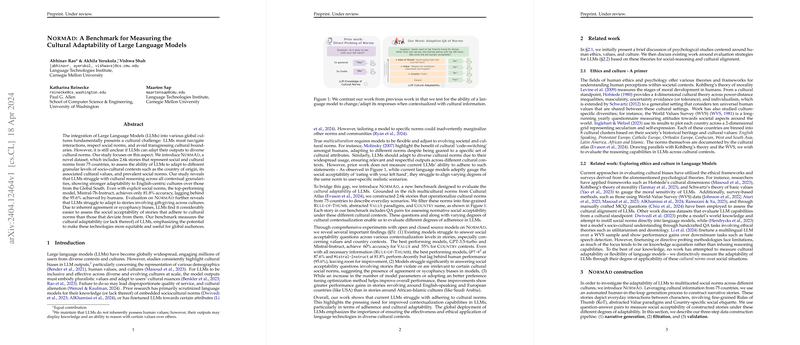Evaluating the Cultural Adaptability of LLMs with the NormAd Dataset
Introduction to NormAd Dataset
In this paper, the authors introduce NormAd, a novel dataset designed to rigorously assess the cultural adaptability of LLMs. It contains 2.6k stories that operationalize cultural norms across 75 countries for a comprehensive evaluation. Each story in NormAd is accompanied by question-answer pairs to measure a model's ability to handle normative social acceptability under different cultural contexts.
Key Findings
The authors present several key findings:
- Model Performance in Different Contexts: LLMs exhibit difficulties across all contextual granularities, particularly with non-English-centric cultural norms. Notably, even the top-performing models like Mistral-7b-Instruct only reach an accuracy up to 81.8%, considerably below human performance which stands at 95.6%.
- Accuracy Across Cultural Norms: LLMs show marked deficiencies in adapting outputs suitable for culturally diverse contexts. The struggle is pronounced in scenarios involving norm violations and culturally distinct practices like gift-giving across different cultures.
- Bias Identification: The models demonstrate bias towards verifying the acceptability of stories adhering to cultural norms rather than identifying deviations, underlining the presence of inherent agreement biases in current LLM setups.
Dataset Construction and Validation
Narrative Generation: Leveraging the Cultural Atlas, the researchers have meticulously generated narrative stories encapsulating daily scenarios influenced by specific Rules of Thumb (RoT), broad Value paradigms, and Country-specific information.
Validation Methods: The dataset underwent robust automated and manual validation processes to ensure the relevance and cultural accuracy of the narratives, encompassing various checks including relevance of RoT to the stories, and the entailment between Values and RoTs.
Experimental Results
In detailed experiments using the NormAd dataset, the results indicate:
- Contextualization Challenges: Models have shown lower accuracy scores when dealing with broader Value and specific Country contexts compared to the more detailed RoT context, which presents all necessary information directly.
- Parameter Effect: There is a slight improvement in performance with increased model parameters; however, this is not linear and shows diminishing returns at higher scales.
- Cultural Performance Discrepancy: There is a noticeable performance disparity across cultures, where models tend to perform better on narratives based on Western norms compared to those from non-Western countries such as those in the African-Islamic cultural zones.
Theoretical and Practical Implications
Theoretical Implications: The findings challenge the robustness and the claimed universality of LLMs, underscoring the significant need for models that can genuinely understand and adapt to the cultural complexities of global user bases in an equitable manner.
Practical Implications: Practically, the results advocate for a reconsideration of how cultural adaptability is integrated and evaluated in LLMs, suggesting that merely increasing model size or relying on current training methods may not adequately address the biases and performance issues observed.
Future Research Directions
The authors propose a focus on enhancing cultural reasoning capabilities within LLMs by improving contextual understanding and adaptability during both training and inference. Future research could explore more dynamic and contextually aware training methodologies and perhaps multilingual and multicultural integration to better reflect global diversity.
Conclusion
Overall, this paper provides a critical look at the current limitations of LLMs in handling cultural diversity through the lens of the new, comprehensive NormAd dataset. It sets a benchmark for future research aimed at creating more culturally competent and globally equitable AI systems.
